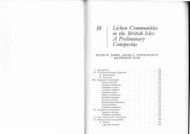Create successful ePaper yourself
Turn your PDF publications into a flip-book with our unique Google optimized e-Paper software.
margin and ± radially aligned. Paraph. scarcely<br />
thickened above. Sp. 11-15 x 6-8 µm<br />
C. aractina<br />
(Possibly to this species: Disk dark rust-red to<br />
blackish. Ap. -0.4 mm, scattered, sitting up, flat,<br />
with blackish margin. Thallus dark gray to bluegray,<br />
areolate to cracked. Exc. dirty green. Sp.<br />
10-14 x 5-7 µm, septum ca. 4-6 µm. Paraph.<br />
scarcely thickened above<br />
. ! C. festivella (Nyl.) Kieffer)<br />
20* Disk (yellow)orange, brown-orange, ochre.<br />
Without blackish prothallus. Ap. usually -1 mm,<br />
<strong>of</strong>ten rather sparse. Thallus greenish-gray, gray,<br />
bluish-gray, black-gray, usually greenish when<br />
moist, relatively thick, areolate, areoles unevenly<br />
warty, <strong>of</strong>ten somewhat raised at the margin and<br />
finally sorediate to granular-warty or blastidiate<br />
there. Paraph. up to 5 µm thick above. Sp. 10-<br />
18 x 5.5-9 µm. Septum ca. 4-5 µm thick<br />
! C. chlorina<br />
(When thallus not granular or sorediate or<br />
blastidiate, gray, gray-brown, black-brown, see<br />
C. conversa (3))<br />
21 Thallus not recognizable or very thin and<br />
indefinite . 22<br />
21* Thallus definitely developed. Paraph. ends only<br />
slightly thickened (2-3(3.5) µm) . 23<br />
22 Ap. yellow-orange, orange, orange-brown, -0.5<br />
(0.7) mm, with orange colored, <strong>of</strong>ten somewhat<br />
shiny margin (rarely (young) outer with apparent<br />
gray thalloid margin), flat to soon moderately<br />
convex and finally marginless, numerous, closestanding.<br />
Sp. 10-16 x 5-8 µm, septum 2.5-5 µm,<br />
¼ -1/2 <strong>of</strong> the spore length. Paraph. ends<br />
thickened up to 4-5 µm above. Hym. 60-75 µm.<br />
Thallus very thin, ± gray, or indefinite.<br />
Commonly on syanthropic and calcareous<br />
substrates, frequently on concrete .<br />
C. holocarpa*<br />
22* Ap. orange, dark orange, orange-red, dirty<br />
orange, orange-brown, even with olive colored<br />
tint, flat, with permanent, orange to orange-red<br />
colored margin, -0.5(0.7) mm, sessile with a<br />
narrowed base, usually rather scattered or in<br />
small groups. Sp. 11-15(15) x 3.5-5.5 µm,<br />
septum 1.5-3.5 µm thick. Paraph. ends gradually<br />
up to 2-3 µm thickened. Hyp. without oil<br />
droplets. Thallus light gray, thin to indefinite<br />
(when sp. 12-15 x 4.5-6.5 µm, septum 2.5-6 µm,<br />
ap. margin disappearing, exc. cortex slightly<br />
blue: ! C. caesiorufella (Nyl.) Zahlbr. (C.<br />
letpocheila H.Magn.)) C. arenaria<br />
23 Sp. 13-17 x 5.5-7, septum 2-3.5 µm thick, ca. 1/5<br />
<strong>of</strong> the spore length. Ap. light to dark orange,<br />
orange-brown, permanently margined, -0.5 (0.7)<br />
mm. Thallus light gray to gray, cracked-areolate<br />
to areolate, <strong>of</strong>ten extensive (probably host<br />
thallus) . C. subpallida*<br />
23* Sp. septum thicker, 1/3 - ½ <strong>of</strong> the spore length 24<br />
24 Ap. rust red, red-brown, with definite, permanent<br />
brown-red margin, -1.0 mm. Thallus dark gray to<br />
gray, coherent-uneven to cracked-areolate. Sp.<br />
12-17(21) x 6-8(10) µm, septum ca. 5-6 µm<br />
. C. crenularia<br />
24* Ap. orange, brown-orange, with lighter, shiny<br />
orange colored thick, flat, convex, projecting,<br />
permanent margin, -0.5(0.7) mm, basally<br />
constricted, <strong>of</strong>ten thick-standing. Paraph. ends<br />
little thickened. Thallus lead- gray to black,<br />
cracked to cracked areolate, with black,<br />
sometimes fibrous prothallus, fleck-like K+<br />
violet. Sp. 12-17 x 8-10 µm, septum 5-7 µm<br />
. C. atr<strong>of</strong>lava*<br />
25 Thallus lobed (placoid) at the margin . 26<br />
25* Thallus not lobed at the margin 38<br />
26 Thallus upper surface entirely mealy-granular to<br />
granular, decorticate, granules mostly ca. 0.15-<br />
0.2mm thick. Thallus well developed ± rounded<br />
and clearly bordered at the margin, indefinitely<br />
effigurate, shiny yellow, thin to thickish.<br />
Medulla whitish. Ap. lacking C. xantholyta<br />
26* Thallus with other characteristics, with definite<br />
cortex, usually rounded-rosetted and with<br />
definite, narrow, marginal lobes (placoid) 27<br />
27 With soralia or ± spherical isidia. Ap. rare 28<br />
27* Without soralia or isidia, usually with ap.; ap.<br />
above all in the center part <strong>of</strong> the thallus 32<br />
28 Thallus without soralia, in the center with<br />
numerous close standing, narrowed at the base, -<br />
0.1 mm thick, spherical isidia, usually -1.5 cm<br />
wide, yellow to yellow-orange. Marginal lobes<br />
very narrow, coalescing C. granulosa<br />
(Attention: In the case <strong>of</strong> C. decipiens sometimes<br />
soralia development is arrested, instead <strong>of</strong> which<br />
lumpy warts are produced, thallus usually over<br />
1.5 cm in size)<br />
28* Thallus with soralia 29<br />
29 Thallus disintegrating sorediate in the center and<br />
citron- to light yellow, at the margin with narrow<br />
(up to 0.5 mm wide) radiating lobules<br />
↑ (C. cirrochroa 31)<br />
29* Thallus with small bordered soralia, usually -2<br />
cm wide 30<br />
30 Thallus with lip- to capitate soralia at the ends <strong>of</strong><br />
small, very short lobules (in the interior and<br />
central region, scarcely in the outer region), not<br />
dying in the interior, light yellow to orangeyellow,<br />
± pruinose, -2(3) cm. Soralia colored<br />
like the thallus. Marginal lobes commonly<br />
closely coalescing, branching toward the end<br />
divisions, sometimes slightly pruinose .<br />
C. decipiens<br />
30* Thallus with small (flat to concave) fleck soralia<br />
at the interior end <strong>of</strong> narrow, radiate arranged<br />
lobules, ca. -1.6 (2.5, rarely more) cm, interior<br />
<strong>of</strong>ten dying and therefore ring form. Marginal<br />
lobes <strong>of</strong>ten forked, closely coalescing to separate<br />
. 31<br />
130





